by Bill Murray
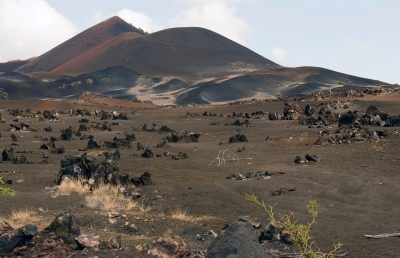
In last month’s column we sailed from Walvis Bay, Namibia, to St. Helena Island, 1800 miles from Angola, 1200 from Brazil, in the middle of the South Atlantic Ocean. This month we continue north to Ascension Island.
When the Brits exiled Napoleon to St. Helena in 1815 they denied the emperor newspapers, subjected him to curfew, and guarded him with 125 men during the day and 72 at night. So intent were they to avoid a second imperial escape that sailing down, they garrisoned Ascension Island on the way, better to defend St. Helena.
Napoleon died six years later. With the Suez Canal fifty years in the future, the Admiralty hung on to Ascension as a sea base and it serves now as an airbase shared with the Americans, who built the island’s Wideawake airfield to move troops in WWII.
Ascension provided the middle link in an airbridge for the United Kingdom’s 1982 Falkland Islands campaign. During that conflict Ascension came alive like never before or since, as the UK Ministry of Defense ran a frenetic schedule of flights between the Brize-Norton air base near Oxford, England, and the RAF’s Mount Pleasant airport near Stanley, in the Falklands.
Other than aboard your own ocean going yacht, at the time of our visit ten years ago, there were only two ways onto and off of Ascension Island: the airbridge, which ran twice weekly charters, and the Royal Mail Ship St. Helena, which supplied St. Helena Island with periodic trips from Cape Town, and usually continued the additional 800 miles northwest to Ascension Island.
Where much of St. Helena is graceful and green, Ascension is stark and volcanic. St. Helena’s population has ancestral roots, while Ascension’s 34 square miles are home to no permanent residents, no farmers, fishermen or private property. St. Helena exports labor via contract workers. Ascension imports most of it.
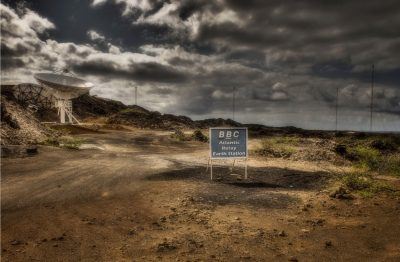
Ascension is home to various NASA satellite tracking stations and military installations. The BBC transmits its World Service broadcasts to Africa and South America from an other-worldly array of broadcast antennae on the island’s northern tip. The military airstrip was lengthened so it could serve as an emergency landing strip for the Space Shuttle. It remains the longest in the Atlantic, supporting the 800 working residents, comprised of a changing coterie of research scientists and a small community of contract workers, like my new friend Nick.
I met Nick on the two day run up from St. Helena. But for a trickle of tourists this was a ferry full of “Saints” like Nick, residents of St. Helena on their way back from Christmas holiday to contract work on Ascension. Nick ran a shop in the neighborhood of Two Boats.
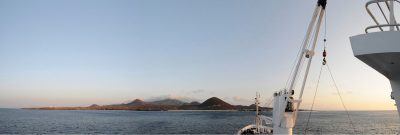
Nick and I sat drinking beer in the open air aboard the RMS St. Helena, out on deck behind the indoor sun lounge. We were escaping the games inside, bingo and the like, meant to entertain passengers grown weary of the monotony of no sight of land.
Nick spoke in bursts, quick half-sentences. He’d make a point and give a knowing nod and a smile, like he’d just heard himself and agreed with what he said. He had things to say about life in the middle of the South Atlantic.
“St. Helena got its problems, y’know? Some people makin’ a fortune. Guy goes off to the Falklands to work, lives almost like a slave. Livin’ in dormitories, cleanin’ up after the Brits. He gets free travel, now, but he makes what, five grand a year, comes home and a house gonna cost him twenty. No way to live.
“And a man ought not have to go away to earn a living anyway. Here I go to Ascension, been there eleven years. Now the good thing: the way you can raise kids. It really is good. I’m bringin’ my son because I have a little shop and my wife, she teaches. No lockin’ doors, keys in the car. 900 people, maybe a thousand, right? Somebody ever takes something, eventually you find it.
“Now they have these clubs, a man doesn’t need money, just sign and have a beer, pay for it on payday. He don’t pay, he can’t leave the island, they take his last paycheck or somethin’.
“Sometimes I say no at my shop. A boy come in, wants a case of beer, if he can’t pay I say no. Otherwise I end up with no beer and no money to buy more. But my father taught me never say no if a man is a couple a pounds short for his kid’s shoes.
“Grinds people down. Some people make too much money, some people really poor, best thing they want is maybe a broken down second hand car. They just never gone anywhere, never seen anything in the world.
“Now I been eleven years on Ascension. I been lucky. Time for me to go back. My father died young. Not young, 62. My mother died in her 50’s. Lucky, my Auntie keeps my business back home. Won’t say I’ll never go back to work on Ascension. You get really big fish there, you know?”
•••••
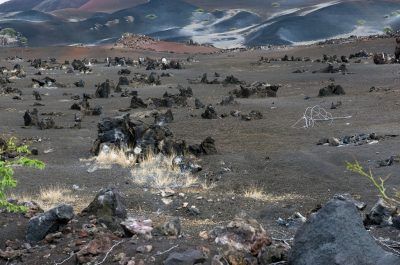
Ascension Island. Hell with the fire put out. Volcanic, 100 kilometers west of the Mid-Atlantic Ridge, the above-water tip of a 3,200 meter high, 60 kilometer wide volcano. Most recent lava flows thought to have been in the last 1,000 years but none since at least 1501. Some eight degrees south of the equator.
Astonishingly young. Its most ancient rocks are no more than a million years old. The slopes descend to the ocean floor, a visitor wrote, like a lorry full of gravel just unloaded, with “the same steepness and regularity, something totally unlikely in a natural mountain.” In the black lava from the most recent eruption NASA tested its LEM, or Lunar Excursion Module.
In ordinary places travelers perform a trivial ritual meant to assure their return, like tossing coins in the Trevi Fountain. On the tip of Chilean South America, you will return to Punta Arenas if you kiss the toe of the Ferdinand Magellan statue.
It’s different on Ascension. The Obsidian Hotel’s island-touting brochure describes a golf course on the road east from Georgetown as the worst on the planet, where “the ‘Greens’ are called ‘browns’ and are made of crushed compacted lava smoothed flat with diesel oil.” Across the road are two canoes stood on end, one third buried, planted in lava.
Logically enough, these boats mark the road to the gaggle of housing called Two Boats, where Nick has his shop. The Ascension travelers’ legend centers on an elaborately painted stone beside the boats. When you are due to leave Ascension you cast paint upon this stone, to assure you need never return.
•••••
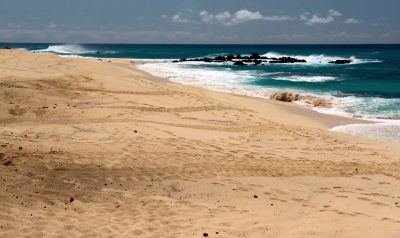
The waters off Ascension are home to spotted and bottlenose dolphins, humpback and Gervais’ beaked whales and the big attraction, the green turtle. The green turtles were laying when we arrived, in December. They would then swim across the Atlantic to Brazil, and return in three or four years to these very same beaches to once again mate and lay their eggs, a behavior scientists call ‘natal homing.’
We joined three conservation officers and four or five others one night for a walk down Long Beach in search of nesting turtles. Ten minutes from the middle of town, an all-enveloping darkness. A very hushed affair broken only by the chest-thumping impact of Atlantic rollers, waves that gather unimpeded for hundreds and hundreds of miles.
The lead conservation person slipped away then back, summoning us to shuffle through the sand toward a massive green turtle nesting on the beach. It’s a rare and fascinating sight, common to no one, even a researcher.
Turtles favor Ascension for the absence of predators. No dogs, no monkeys. The Ascension green turtles are the largest in the world, a meter and a half long, weighing as much as 300 kilos. Green Turtles are between 20 and 40 years old when they make the journey for the first time, males and females swimming together to mate.
A turtle will nest as many as ten times at intervals of 10-17 days. Once she has dug a large pit with all of her flippers the turtle digs a chamber with her hind flippers into which she lays around 120 ping-pong sized eggs.
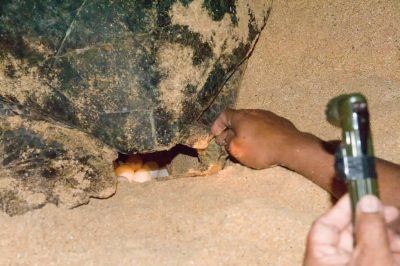
Both laying and hatching happen at night. One hatchling after another pops out on to the sand and races for the sea. They are born all at once. Only by working in numbers can they generate sufficient strength to burrow up through the sand. Once out in the air, their numbers increase the chances some will survive the headlong dash into the surf.
Everything about these turtles is remarkable, but the poet Amit Majmudar reminds us that all animals are “routinely superhuman in one way or another. They outstrip us in this or that perceptual or physical ability, and we think nothing of it.”
Perhaps because we live our lives in conscious thought, we discount the astonishing ways our fellow beings, seemingly unconsciously, navigate the world. Green turtles appear to use their own internal maps of the Atlantic Ocean. Some migratory birds seem to navigate by the pole point, the due north spot in the sky around which the sky rotates.
Ants’ ocelli, light-sensitve organs on their heads, can read the sky even when the sun is obscured by cloud, using patterns of polarized light to orient themselves. The cataglyphis ant uses an internal odometer to keep track of outbound steps to then find its way home.
Other ants seemingly do trigonometry, taking circuitous routes outbound then the most direct route back to their nests, figuring out spatial relationships between the various places they’ve been each day.
Honeybees use polarized light to find the most direct way back to the hive – a beeline. This with brains of fewer than one million neurons and with 20/2000 vision. Also shown to use polarized light: Monarch butterflies, lizards, shrimp, lobsters, cuttlefish, crickets, and rainbow trout as well as numerous migratory birds. And maybe, so did the Norse.
•••••
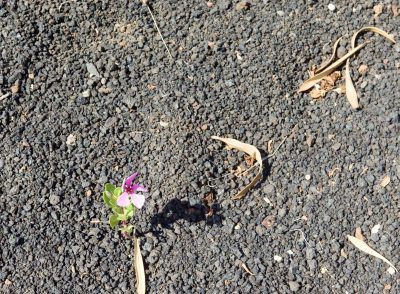 Human navigation away from Ascension Island in 2010 meant either sailing back to St. Helena Island aboard the RMS St. Helena, which has since been retired, or flying via the airbridge to the United Kingdom or the Falkland Islands. Since 2017 maintenance at the Wideawake airbase has precluded landing of larger aircraft, and the Falklands airbridge is for now rerouted via Cape Verde. Current options for getting to and from Ascension are even fewer than those ten years ago.
Human navigation away from Ascension Island in 2010 meant either sailing back to St. Helena Island aboard the RMS St. Helena, which has since been retired, or flying via the airbridge to the United Kingdom or the Falkland Islands. Since 2017 maintenance at the Wideawake airbase has precluded landing of larger aircraft, and the Falklands airbridge is for now rerouted via Cape Verde. Current options for getting to and from Ascension are even fewer than those ten years ago.
We took the airbridge. A testudinologist (studies turtles and tortoises) named Sergio Ghione wrote that at the time of his work on Ascension, the Airbridge was a grim military affair, with the first row or two of seats removed in order to accommodate stretchers. By the time of our visit, at a non-military time, flights staged to and from RAF Brize Norton using charter contractors, like the Scottish company Flyglobespan, which had the contract until it filed for bankruptcy a month before our scheduled flight.
Unsure who might fly in to pick us up, we assembled to leave Ascension in a little chain link holding pen just off the Wideawake Field tarmac, and a brightly-colored Air Tahiti Nui widebody arrived to pick us up, which later set up a jarring visual as the airliner, in its merry Polynesian livery, glided in to touch down at RAF Brize Norton, Oxfordshire, in the snow.
•••••
Additional reading:
On Ascension Island: Turtle Island by Sergio Ghione, and Island Base: Ascension Island in the Falklands War by Captain Bob McQueen.
On animal navigation, By the Light of the Moon, the Poles of the Earth, The remarkable ways animals get around by Sally Davies. For a tour of the odd capabilities of some really strange living things try Ten Million Aliens by Simon Barnes.
On human navigation try Wayfinding by M. R. O’Connor, The Wayfinders: Why Ancient Wisdom Matters in the Modern World by Wade Davis and The Old Way by Elizabeth Marshall Thomas.
